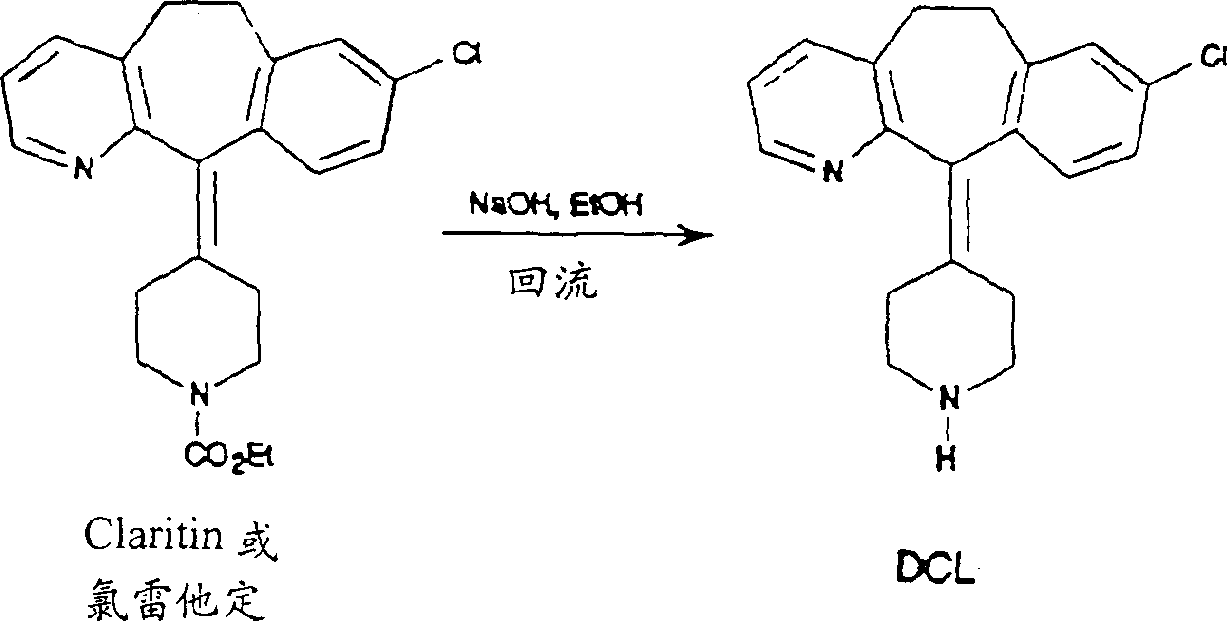Usage of treating allergic rhinitis and other disorders using descarboethoxyloratadine
A technology of decarboxyethoxy loratadine and carboethoxy loratadine, applied in hepta[1, a new method, decarboxyethoxy loratadine, relates to a treatment related to diabetes, capable of Fix issues like bad interactions
- Summary
- Abstract
- Description
- Claims
- Application Information
AI Technical Summary
Problems solved by technology
Method used
Image
Examples
Embodiment 1
[0066] 4.1 Example 1: Preparation of loratadine and its metabolites
[0067] Loratadine can be synthesized by the method taught in US Patent 4,282,233. Metabolites thereof are similarly prepared using reaction procedures conventional in the art, as described in US Patent 4,659,716, the contents of which are incorporated herein by reference. A common method for preparing DCL is to reflux loratadine in NaOH and ethanol as shown below.
[0068]
[0069] Extraction of commercial medicine Claritin tablet (600×10mg)
[0070] Dilute loratadine tablets with water and chloroform. The mixture was stirred, then filtered through Celite, rinsing with chloroform until the filtrate was free of loratadine. The separated aqueous layer was extracted twice with chloroform. The combined organic layers were washed with brine and dried over sodium sulfate. Evaporation of the solvent gave pure white immobilized loratadine.
[0071] Saponification of Loratadine
[0072] Loratadine (4.0 g) w...
Embodiment 2
[0074] Antihistamine activity
[0075] The antihistamine activity of loratadine and DCL was compared using isolated guinea pig ileal strips against histamine contractility. This method is widely accepted by those skilled in the art as a method for predicting the efficiency of peripheral histamine H-1 receptors.
[0076] method:
[0077] Experiments were performed on ileal segments taken from male guinea pigs (Hartley strain, 419-560 g; Elm Hill Breeding Laboratories, Chelmsford, MA). The tissue was suspended in a tissue chamber containing 40mL Tiger solution, filled with 95% oxygen and 5% CO 2 , cultured at 35°C. Tiger solution includes (mM) 137NaCl, 2.7KCl, 2.2CaCl 2 , 0.025MgCl 2 , 0.4NaHPO 4 , 11.9NaHCO 3 and 5.5 glucose. Contractions produced in response to histamine were recorded with an isotonic transducer (Model 357, Harvard Instruments, South Natick, MA) and a Modograph (Model 7, Grass Instruments, Quincy, MA). A tension of 1 gram was maintained in all tissues...
Embodiment 3
[0088] receptor binding assay
[0089] Receptor binding assays for the binding affinity of loratadine and DCL to the histamine H-1 receptor were performed.
[0090] The method of Dini et al., which is incorporated herein by reference (Agents and Actions, 33:181-184, 1991), was used in this binding assay. Guinea pig cerebellum was incubated with 0.5 nM 3H-pyrilamine at 25°C for 10 minutes, then assayed using a Brandel cell harvester, filtered through GF / B glass fiber filter paper (Whatman) under vacuum, and ice-cold buffer Fluid several times. Bound radioactivity was determined with a liquid scintillation meter (LS 6000, Beckman) by using liquid scintillation fluid (Formula 989, DuPont NEN).
[0091] The IC of the tested compounds and neoantigen on the H-1 histamine receptor was determined. 50 value.
[0092] H-1 receptor
compound
Loratadine
DCL
IC 50 (nM)
721
51.1
1.4
(nH)
(1.55)
(1.12)
(0.98)...
PUM
 Login to View More
Login to View More Abstract
Description
Claims
Application Information
 Login to View More
Login to View More - R&D
- Intellectual Property
- Life Sciences
- Materials
- Tech Scout
- Unparalleled Data Quality
- Higher Quality Content
- 60% Fewer Hallucinations
Browse by: Latest US Patents, China's latest patents, Technical Efficacy Thesaurus, Application Domain, Technology Topic, Popular Technical Reports.
© 2025 PatSnap. All rights reserved.Legal|Privacy policy|Modern Slavery Act Transparency Statement|Sitemap|About US| Contact US: help@patsnap.com

